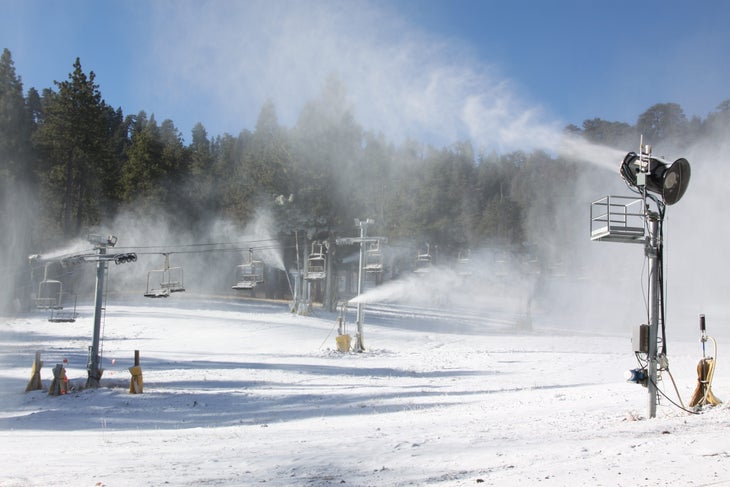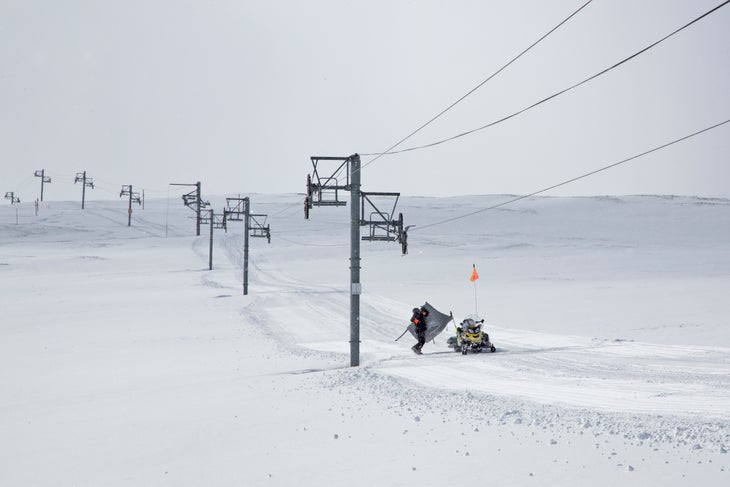Heading out the door? Read this article on the new Outside+ app available now on iOS devices for members! Download the app.
Like an overly optimistic skier sending a questionable cliff, the ski season came to a crashing halt in March when the Covid-19 pandemic reached ski resorts and mountain towns across the country.
These places became early hot spots for virus outbreaks, and in an unprecedented event, Vail Resorts shuttered operations at all of its North American mountains on March 15. Alterra Mountain Company closed its resorts indefinitely. The governor of Colorado issued an executive order suspending all downhill skiing operations. Around the country, ski areas closed. And, just like that, the ski season was over.
Most importantly, terrible seasons have almost always led to innovations in the industry. So instead of just trying to forget the bad seasons, skiers should use this year as an opportunity to learn.
Related: The Ultimate Connection
A History of Bad Ski Seasons Part 1 – Weather
The most recent bad season in terms of weather in the West was in 2017-’18, which was reported to be one of the driest seasons on record for U.S. ski resorts. Snowfall at ski resorts near Lake Tahoe was down 45 percent compared to the season before, Crested Butte was down 57 percent.
Video: Governor Shows California’s Low Snowpack
Can’t see the video? Click here.
At Taos Ski Valley, the resort called on local Native Americans to perform a snow dance, but with no luck. Taos ended the season with only 78 inches of snowfall, a full 60 percent decline from the previous year. And the 2017-’18 season wasn’t an anomaly. Resorts have been recording record warm winters regularly over the past decade.
The 2015-’16 season was dubbed the ‘non-winter’ on the East Coast. The season before that was considered the worst ski season in Utah’s history, some resorts in Canada didn’t even open, and skiers at Whistler Blackcomb had to ride trams to mid-mountain just to reach snow.
Ask any old-timer in the West about the worst season ever, and they’ll likely tell you about the winter of 1976-’77.
At the time, snowmaking was mostly nonexistent, so in 1976, when the ski season arrived, the snow didn’t and ski areas started to feel the heat. As slopes remained starved for snow, Governor Brown of California declared an official drought. At Whistler, rental shop employees stood guard in front of rocky patches on the slope, demanding their customers take their skis off and walk down through the rocks.
Colorado was just as bad. Aspen only saw 15 inches of snowfall between Nov. 1st and Dec. 26. In Steamboat, locals shoveled snow from the trees onto the barren slopes. By December, Colorado Senator Haskell urged President Ford to declare Colorado’s high country a disaster area eligible for economic relief, but his plea had the reverse effect when tourists heard the news and began canceling their winter vacations. Crested Butte reported 100 percent lodging cancellations before Christmas, and Telluride and Purgatory didn’t open for the holidays.
The industry had barely begun to recover when it happened again in 1980-’81. As yet another drought left slopes completely parched, resorts started looking for ways to compensate for low snowfall.
Michael Berry, the president of the National Ski Areas Association at the time, remembers that season as an “epiphany year for the industry in the Rocky Mountain West. There might have been some people saying they didn’t need snowmaking going into that season, but no one—no one—was saying that coming out.”
Result: The Artificial Snow Revolution

After the 1976-’78 and 1980-’81 seasons, the industry evolved. Snowmaking became widespread, and resorts were able to ensure snow, even in drought years.
Old snowmaking technology was expensive, energy-intensive, and created boilerplate textured snow. New, high-tech snowmaking systems are more efficient, increasing the rate of conversion from water to snow without requiring an increase in water, and can even operate at warmer temperatures than they used to. Some systems are now automated, activating snowmaking during favorable conditions.
These new systems not only create better-quality snow than they used to, but they also allow resorts to open earlier and close later, effectively extending the ski season, and saving the season during warmer years.
During the ‘non-winter’ of 2015-’16 in the East, Loon Mountain reportedly received only 66 inches of snowfall, but after having invested $3 million to double their snowmaking capacity and upgrade efficiency by 75 percent, Loon credited the new snowmaking system for rescuing the season. And it isn’t just Loon that is putting money into these new technologies; resorts from the East to the West are innovating to give skiers reliable snow.
However, the industry still faces the challenges of a warming climate. A study by the Climate Impact Lab in 2018 found that if the current warming trend continues, resorts should expect to lose a month of the ski season within the next two decades. This will likely prompt new innovations in snowmaking.
A History of Bad Ski Season Part 2 – Economics
The ski world has weathered its share of financial crises, none more impactful than the Great Recession of 2008. Heading into the Recession, the industry was experiencing a period of remarkable growth, especially within the real-estate sector. A major player at the time was Intrawest, originally a real-estate development company that by 2008 operated a dozen ski resorts and had popularized the “base area village” development model.
After the Recession hit, destination travelers across the country canceled skiing for the season, and resorts slashed their budgets. The more invested in real-estate the resorts were, the harder they were hit. Loaded with debt, Intrawest was forced to sell its resorts.
Result: The Rise of Multi-Resort Passes
Intrawest rival Vail Resorts was not immune to the effects of the recession. During the 2008-’09 season, it saw declines in lift ticket revenue by 9 percent and overnight bookings fall by 13 percent. CEO Rob Katz reduced his annual salary to $1. Unlike Intrawest, however, Vail Resorts made it out of the recession unfazed. The reason? The Epic Pass. Before the economy plunged, Vail had unveiled its new product: A reimagined value pass that gave customers access to every Vail-owned resort. Skiers were able to buy the multi-destination pass at an affordable price ahead of the season.
When other resorts, who still relied on day ticket sales and destination skiers, took hard hits during the recession, Vail had already secured a huge chunk of revenue before the snow even fell. The “Epic Pass Model” has since changed the industry. Resorts have largely ditched their investments in real-estate developments and focused on delivering better pass products to skiers.
Today, between Vail and Alterra, skiers have never had so many options for places to ski at affordable prices. That might have never happened if not for the 2008 recession shaking up the industry.
Read more: The Current State of Ski Resorts
History of Bad Ski Seasons Part 3: Pandemic

After the abrupt end to the season in March, a handful of resorts across the country, including Timberline in Oregon and Arapahoe Basin in Colorado, reopened for spring and summer skiing.
After closing down due to the Governor’s order, A-Basin was determined to maintain their snow base in anticipation of re-opening. The ski area got the green light by local health officials to start spinning lifts again on May 27, as long as some new regulations were put into place. Skiers must wear face coverings, only ride the lift with people they came with, and maintain distancing where possible.
In a Facebook video announcement, CEO Alan Henceroth said that “This is going to be different than anything else we’ve done at Arapahoe Basin…. But more than anything, we get to go skiing again.” Moments after A-Basin opened its new online reservation system to the public, over 4,000 eager skiers attempted to reserve the 600 open spots, crashing the system almost immediately.
This new way of skiing may seem different and strange, but A-Basin’s test run could serve as a model for what we can expect come next winter. Like amateur snow forecasters trying to predict next season’s snowfall, no one can say with certainty what next year, or even the coming years, will look like for the industry.
But if history has taught us anything, even if the coming ski seasons don’t go as planned, skiing will always find a way.
Related: The Ultimate Connection
